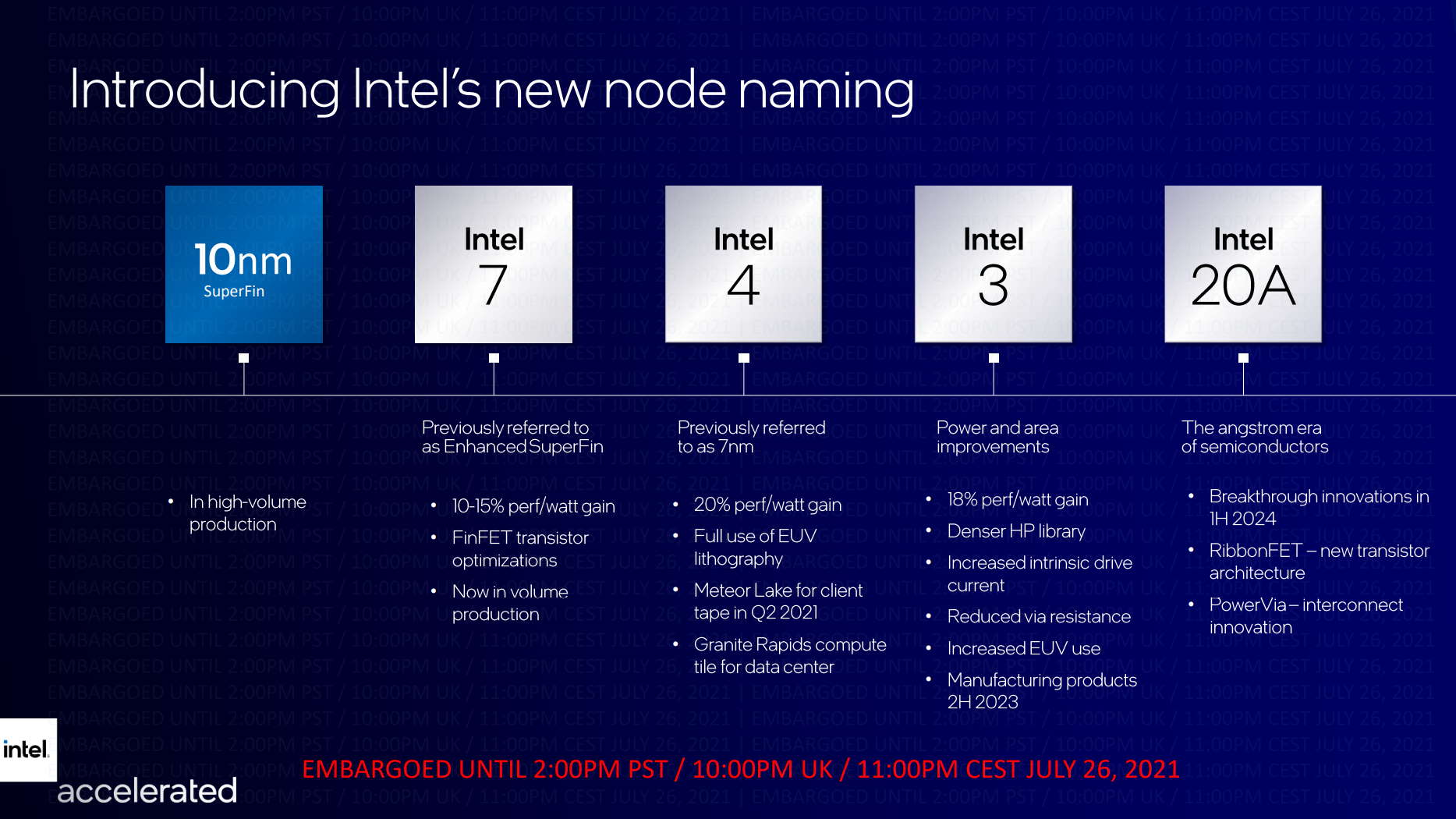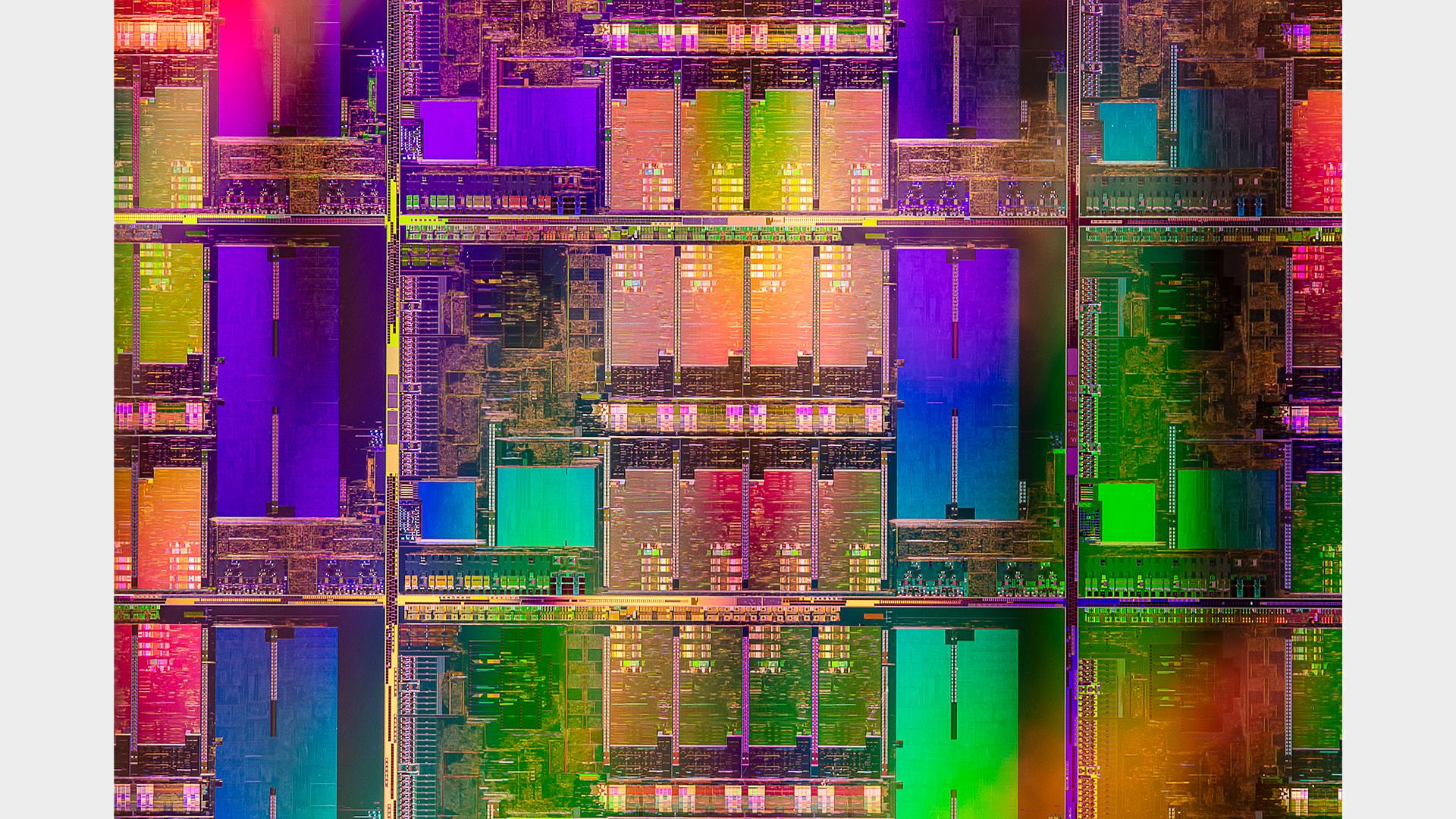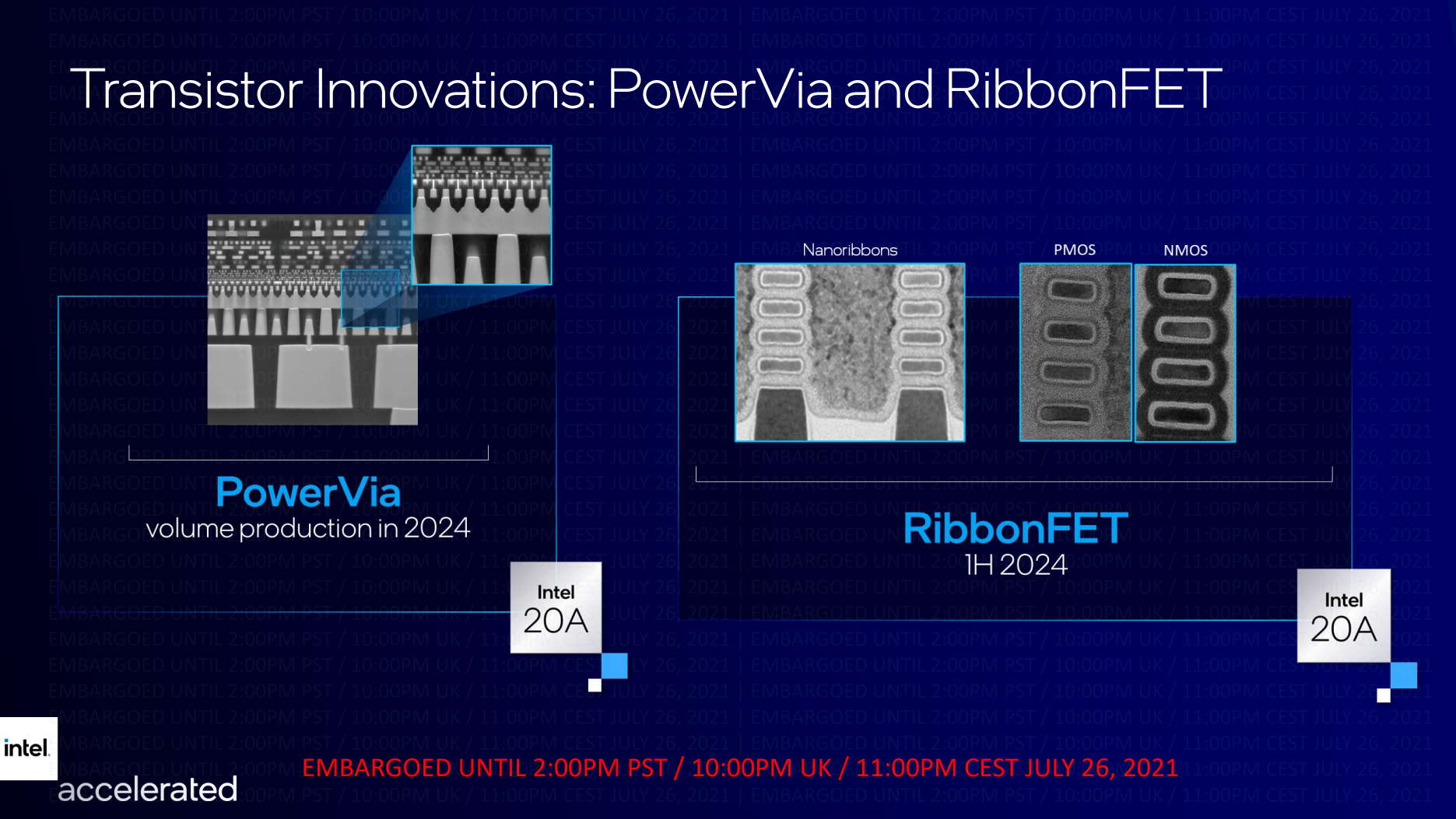Nanometer no more: Intel changes its process names to match TSMC | PC Gamer - powelllize1960
Nanometer no much: Intel changes its summons names to match TSMC

Intel is matching foundry rival, TSMC, node-for-knob with its spic-and-span process naming conventionality, but has also fired the first shot in the race for sub-nanometer terminology. Below 1nm, we're moving into what it's now calling the 'angstrom era of semiconductors'.
At the Intel Accelerated event CEO, Pat Gelsinger, has disclosed a detailed process roadmap for its future nodes, all laced into a new way to source them. "We are fast our innovation roadmap to ensure we are on a clear path to process performance leadership by 2025," he says.
Gelsinger goes along to note that Intel "will be relentless in our pursuit of Moore's Law and our path to innovate with the magic of silicon."
You've got to love the way that Gelsinger is speaking about his caller straight off helium's back and in the top job. I can't imagine Bob Drift or Brian Krzanich ever talking about 'the magic of silicon,' and IT's refreshing to have some passion back in there with Intel's latest CEO.
This speedup and rhenium-marketing also reads as a smart move with Intel pushing forward with its IDM 2.0 strategy and launching its contract foundry business enterprise to rival the likes of TSMC. And what better way to measure yourself against the competition than past aligning your node naming conventions with theirs?
The industry has been talking almost shifting the way it dialogue about process nodes for a while, with the nanometer terminology—once used to denote the logic gate length of a transistor—meaningful to a lesser extent and less as time's expended connected. From the import transistors went three dimensional, with the move out to FinFET (surgery Tri-Gate in Intel nomenclature) in 2011, a single dimension measurement has been rendered entirely digressive.
This has meant Intel increasingly looks behind the times. Through its manufacturing partner, TSMC, AMD has been able to show off nominally 7nm CPUs while Intel's desktop chips still languish happening an old 14nm node.
But, as we've on a regular basis pointed out here on PC Gamer, when it comes to transistor density, Intel's 10nm lymph node is far to a greater extent cognate to TSMC's N7, or 7nm node.
Which is why Intel is forgetting all that nanometer guff and, from the Enhanced SuperFin node forming the ground of the upcoming Alder Lake CPUs, will be using a novel convention. World-class up will be 'Intel 7', which is the hot name for the nominally 10nm Enhanced SuperFin node, and lines up against TSMC's N7 process.

Intel 7 is in loudness product right now, and Intel claims handsome it a new key is fair because of the 10 - 15% performance per watt gains this knob is giving over the previous 10nm SuperFin. That's the sort of perf jump you'd expect from a new cognitive operation, and Intel is now marketing information technology atomic number 3 such.
After that we stumble 'Intel 4', which was previously referred to as 7nm and will line up against TSMC's N4 process, then we'll get 'Intel 3', and you can guess which match node that's going head-to-oral sex with.
Intel describes the advanced road map in a small Sir Thomas More detail:
- Intel 7 delivers an approximately 10% to 15% performance-per-watt increase versus Intel 10nm SuperFin, supported FinFET transistor optimizations. Intel 7 will be featured in products such as Alder Lake for node in 2021 and Sapphire Rapids for the data center, which is expected to atomic number 4 in output in the first quarter of 2022.
- Intel 4 fully embraces EUV lithography to publish incredibly small features using ultra-short wavelength light. With an approximately 20% performance-per-watt increment, along with area improvements, Intel 4 will be ready for production in the endorsement half of 2022 for products transport in 2023, including Meteor Lake for client and Granite Rapids for the information snapper.
- Intel 3 leverages encourage FinFET optimizations and redoubled EUV to deliver an approximately 18% performance-per-watt addition finished Intel 4, on with additional area improvements. Intel 3 will be ready to begin manufacturing products in the last half of 2023.
- Intel 20A ushers in the angstrom era with cardinal breakthrough technologies, RibbonFET and PowerVia. RibbonFET, Intel's implementation of a gate-every last-around transistor, will be the troupe's first brand-new junction transistor computer architecture since information technology pioneered FinFET in 2011. The engineering science delivers faster transistor switching speeds while achieving the same drive current as sixfold fins in a smaller footprint. PowerVia is Intel's unique industry-start implementation of backside power delivery, optimizing signal transmission by eliminating the penury for magnate routing on the front sidelong of the wafer. Intel 20A is due to ramp in 2024.
- 2025 and On the far side: On the far side Intel 20A, Intel 18A is already in development for embryonic 2025 with refinements to RibbonFET that bequeath deliver some other major jump in transistor performance. Intel is also working to define, anatomy and deploy following –generation High NA EUV, and expects to encounter the low production tool in the industry. Intel is partnering close with ASML to assure the achiever of this industry breakthrough beyond current generation of EUV.

Admittedly, the whole melodic theme is to a lesser extent for the like us and is more about marketing itself to potential customers for its newcomer foundry business. Though it will hopefully make it clearer where different process nodes queue up against each past when we're talking most unaccustomed chips from different manufacturers.
After that is where things pose fantastic-interesting though, as beyond the Intel 3 products shipping at the tail end of 2023, we then enter upon another wholly new naming convention. This is the industriousness haunting towards a nominally sub-1nm era, with the name 'Intel 20A' being liberal to its early new process node of the angstrom era of semiconductors in the first half of 2024.
Though this mightiness be where Intel's simplified node naming convention gets complicated again. An angstrom is literally a sub-nanometer unit of mensuration, with matchless angstrom equalling 0.1nm. Simply Intel is at pains to remonstrate that, scorn the 'A' in 'Intel 20A' vertical for A, it is strictly a bring up, not a measurement. So, to be clear, Intel 20A is not a cognitive process incorporating transistors measuring 2nm in terms of their logic gate length.

These new A era chips not only come with a new naming convention—that I'm sure Intel will hope catches on—simply volition also incorporate the first new Intel transistor design since that 22nm FinFET in 2011. RibbonFET, also called NanoSheet, OR circuit All Around (GAA), will land with Intel 20A in 2024. It's a transistor design that should speed ascending the switching (from 0s to 1s) as fountainhead as being able to meet the power demands of modern CPUs in an ever small, more densely packed environment.
Intel 20A will also unified a young power delivery method, call PowerVia. That in itself wish offer the three dimensional chips of tomorrow something called 'stern power delivery' optimising against leakage and for betoken transmission by removing the need to have power routing on the front English of a given wafer.
This is every last fantastic techy manufacturing process style shove, and a trifle future gazing. But the short of it is that Intel is aiming to have process carrying into action per watt leadership by the time its Intel 18A node rolls around in 2025. Though Intel reps are keen to signalise that is a real various affair to having products with performance leadership—it's expecting to have those much sooner.
Source: https://www.pcgamer.com/intel-renames-process-nodes-intros-angstrom-era-of-semiconductors/
Posted by: powelllize1960.blogspot.com



0 Response to "Nanometer no more: Intel changes its process names to match TSMC | PC Gamer - powelllize1960"
Post a Comment